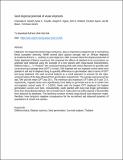| dc.description.abstract | Elephants, the largest terrestrial mega-herbivores, play an important ecological role in maintaining forest ecosystem diversity. While several plant species strongly rely on African elephants (Loxodonta africana; L. cyclotis) as seed dispersers, little is known about the dispersal potential of Asian elephants (Elephas maximus). We examined the effects of elephant fruit consumption on potential seed dispersal using the example of a tree species with mega-faunal characteristics, Dillenia indica L., in Thailand. We conducted feeding trials with Asian elephants to quantify seed survival and gut passage times (GPT). In total, 1200 ingested and non-ingested control seeds were planted in soil and in elephant dung to quantify differences in germination rates in terms of GPT and dung treatment. We used survival analysis as a novel approach to account for the right-censored nature of the data obtained from germination experiments. The average seed survival rate was 79% and the mean GPT was 35 h. The minimum and maximum GPT were 20 h and 72 h, respectively. Ingested seeds were significantly more likely to germinate and to do so earlier than non-ingested control seeds (P = 0.0002). Seeds with the longest GPT displayed the highest germination success over time. Unexpectedly, seeds planted with dung had longer germination times than those planted without. We conclude that D. indica does not solely depend on but benefits from dispersal by elephants. The declining numbers of these mega-faunal seed dispersers might, therefore, have long-term negative consequences for the recruitment and dispersal dynamics of populations of certain tree species. | en_US |

